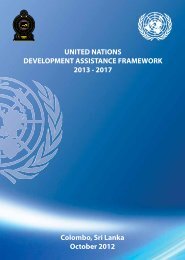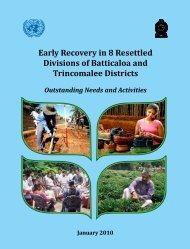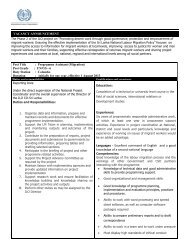Sri Lanka Human Development Report 2012.pdf
Sri Lanka Human Development Report 2012.pdf
Sri Lanka Human Development Report 2012.pdf
Create successful ePaper yourself
Turn your PDF publications into a flip-book with our unique Google optimized e-Paper software.
This is a considerable task, but it must be tackled. As<br />
this report has tried to demonstrate, <strong>Sri</strong> <strong>Lanka</strong> confronts<br />
numerous development challenges without the financial<br />
and human resources to deal with all of them at the<br />
same time. Any new development strategy will need to<br />
establish priorities, identify and exploit synergies, and<br />
ensure sustainability. This will not happen during the<br />
short-term, especially if the goal is human development,<br />
which by nature is a long-term commitment engaging<br />
all stakeholders. <strong>Sri</strong> <strong>Lanka</strong> has the potential to be a<br />
development leader in South Asia, but to realize that, it<br />
must make such a commitment.<br />
With the end of civil conflict and an overwhelming victory<br />
in the last election, the Government has the political<br />
capital to do so. It is also necessary to convince different<br />
stakeholders of the need for change and to secure their buy<br />
in so that socio-political differences do not hold back wellconceived<br />
policy changes.<br />
Major challenges include disparities across provinces,<br />
urban and rural areas and the estates, and persistent<br />
poverty, especially among deprived population groups.<br />
Key health issues encompass poor nutrition, along with<br />
the need to improve good quality and comprehensive<br />
health services in deprived locations, and reorganize the<br />
health system to respond to non-communicable and<br />
other emerging diseases. On the education front, access to<br />
basic education for the most deprived population groups<br />
needs to increase, while the whole country would benefit<br />
from the modernization and expansion of collegiate and<br />
tertiary level education, and vocational training. All levels<br />
of education require more and better teachers in English,<br />
Mathematics, Science and Technology.<br />
Employment challenges include mismatches between<br />
the competencies of graduates and the demands of the<br />
labour market. High unemployment prevails among<br />
young people, women and the educated in general. Heavy<br />
dependence on agriculture for employment continues,<br />
especially outside the Western Province, even as agricultural<br />
productivity remains low. Across the country, people need<br />
more housing, a more adequate network of roads, better<br />
transportation systems, and increased access to electricity,<br />
water and information technology.<br />
Many of these challenges should not be sequentially<br />
pursued, since there are overlaps, linkages and dynamic<br />
feedback effects. Poor education, poor health, malnutrition<br />
and poverty are problems that influence each other and<br />
need to be addressed at the same time. The traditional<br />
approach to health as simply the outcome of actions in the<br />
health sector, is not likely to be successful, for example.<br />
Health is influenced by policies and actions linked to<br />
issues from education to employment to migration. In<br />
establishing priorities, synergies have to be exploited, not<br />
simply noted and put aside.<br />
Three issues require urgent consideration by relevant<br />
authorities. First, <strong>Sri</strong> <strong>Lanka</strong> has reached a stage where it is<br />
necessary to modernize, diversify and upgrade education<br />
and health services. Greater private participation is<br />
needed to move forward, given resource and technological<br />
limitations in the public sector. Exactly how to do this is<br />
something that should be studied and carefully debated.<br />
Already, unregulated private participation has underscored<br />
the need to ensure quality and standards of services, means<br />
for monitoring and fair access.<br />
Second, the dire shortage of resources, rising demand and<br />
competing priorities point to the need to streamline and<br />
prioritize publicly provided health and education services,<br />
while encouraging private provision in other areas.<br />
These measures must be complemented by governance<br />
mechanisms to ensure monitoring and compliance. Care<br />
will need to be exercised so that administrative costs do<br />
not exceed benefits.<br />
Third, special and perhaps preferential attention is<br />
required for conflict-affected areas, the estates and remote<br />
rural areas where poverty is high, malnutrition widespread<br />
and educational outcomes low. In-depth knowledge on<br />
the special challenges of extending public services to these<br />
areas needs to be acquired in order to integrate them<br />
into the mainstream of life and provide amenities similar<br />
to those enjoyed by the rest of <strong>Sri</strong> <strong>Lanka</strong>ns. This process<br />
could be understood as both a development priority, and a<br />
prerequisite for peace and security.<br />
120<br />
sri lanka <strong>Human</strong> <strong>Development</strong> report 2012






